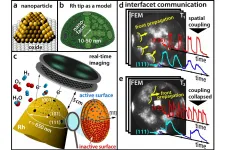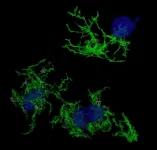Nanoparticles: The complex rhythm of chemistry
Nanoparticles are often used as catalysts. The chemical reactions on their surface are more complex than previously thought, experiments at TU Wien (Vienna) show.
2021-05-21
(Press-News.org) Most of commercial chemicals are produced using catalysts. Usually, these catalysts consist of tiny metal nanoparticles that are placed on an oxidic support. Similar to a cut diamond, whose surface consists of different facets oriented in different directions, a catalytic nanoparticle also possesses crystallographically different facets - and these facets can have different chemical properties.
Until now, these differences have often remained unconsidered in catalysis research because it is very difficult to simultaneously obtain information about the chemical reaction itself and about the surface structure of the catalyst. At TU Wien (Vienna), this has now been achieved by combining different microscopic methods: with the help of field electron microscopy and field ion microscopy, it became possible to visualize the oxidation of hydrogen on a single rhodium nanoparticle in real time at nanometer resolution. This revealed surprising effects that will have to be taken into account in the search for better catalysts in the future. The results have now been presented in the scientific journal Science.
The rhythm of chemical reactions
"In certain chemical reactions, a catalyst can periodically switch back and forth between an active and an inactive state," says Prof. Günter Rupprechter from the Institute of Materials Chemistry at TU Wien. "Self-sustaining chemical oscillations can occur between the two states - the chemist Gerhard Ertl received the Nobel Prize in Chemistry for this discovery in 2007."
This is also the case with rhodium nanoparticles, which are used as a catalyst for hydrogen oxidation - the basis of every fuel cell. Under certain conditions, the nanoparticles can oscillate between a state in which oxygen molecules dissociate on the surface of the particle and a state in which hydrogen is bound.
Incorporated oxygen changes the surface behaviour
"When a rhodium particle is exposed to an atmosphere of oxygen and hydrogen, the oxygen molecules are split into individual atoms at the rhodium surface. These oxygen atoms can then migrate below the uppermost rhodium layer and accumulate as the subsurface oxygen there," explains Prof. Yuri Suchorski, the first author of the study.
Through interaction with hydrogen, these stored oxygen atoms can then be brought out again and react with hydrogen atoms. Then, there is again room for more oxygen atoms inside the rhodium particle and the cycle starts again. "This feedback mechanism controls the frequency of the oscillations", says Yuri Suchorski.
Until now, it was thought that these chemical oscillations always took place synchronously in the same rhythm over the entire nanoparticle. After all, the chemical processes on the different facets of the nanoparticle surface are spatially coupled, as the hydrogen atoms can easily migrate from one facet to the adjacent facets.
However, the results of the research group of Prof. Günther Rupprechter and Prof. Yuri Suchorski show that things are actually much more complex: Under certain conditions, the spatial coupling is lifted and adjacent facets suddenly oscillate with significantly different frequencies - and in some regions of the nanoparticle, these oscillating "chemical waves" do not propagate at all.
"This can be explained on an atomic scale," says Yuri Suchorski. "Under the influence of oxygen, protruding rows of rhodium atoms can emerge from a smooth surface." These rows of atoms can then act as a kind of "wave breaker" and hamper the migration of hydrogen atoms from one facet to another - the facets become decoupled.
If this is the case, the individual facets can form oscillations of different frequences. "On different facets, the rhodium atoms are arranged differently on the surface," says Günther Rupprechter. "That's why the incorporation of oxygen under the differing facets of the rhodium particle also proceeds at different rates, and so oscillations with different frequencies result on crystallographically different facets."
A hemisphere tip as a nanoparticle model
The key to unravelling this complex chemical behaviour lays in using a fine rhodium tip as a model for a catalytic nanoparticle. An electric field is applied, and due to the quantum mechanical tunnelling effect, electrons can leave the tip. These electrons are accelerated in the electric field and hit a screen, where a projection image of the tip is then created with a resolution of around 2 nanometers.
In contrast to scanning microscopies, where the surface sites are scanned one after the other, such parallel imaging visualizes all surface atoms simultaneously - otherwise it would not be possible to monitor the synchronization and desynchronization of the oscillations.
The new insights into the interaction of individual facets of a nanoparticle can now lead to more effective catalysts and provide deep atomic insights into mechanisms of non-linear reaction kinetics, pattern formation and spatial coupling.
INFORMATION:
Research funded by the Austrian Science Fund (FWF) within Project "Spatial-temporal phenomena on surface structure libraries".
Contact
Prof. Günther Rupprechter
Institute of Materials Chemistry
TU Wien
+43 1 58801 165100
guenther.rupprechter@tuwien.ac.at
Prof. Yuri Suchorski
Institute of Materials Chemistry
TU Wien
+43 1 58801 165106
yuri.suchorski@tuwien.ac.at
[Attachments] See images for this press release:

ELSE PRESS RELEASES FROM THIS DATE:
2021-05-21
SINGAPORE, 21 May 2021 - Alzheimer's Disease is the most common form of dementia and is characterised by the build-up of amyloid plaques in the brain. Microglia, the immune sentinels of the brain, are not only responsible for eliminating foreign invaders, but also maintaining brain homeostasis by clearing toxic waste such as the amyloid plaques.
However, the role of microglia in Alzheimer's Disease and its relationship to amyloid plaque accumulation remain unclear. Now, a team of scientists from Duke-NUS Medical School and Monash University have found the gene expression signatures underlying microglia associated ...
2021-05-21
More than 100 kg of highly toxic uranium (U) and plutonium (Pu) was dispersed in the form of tiny 'hot' radioactive particles after the British detonated nine atomic bombs in remote areas of South Australia, including Maralinga.
Scientists say that these radioactive particles persist in soils to this day, more than 60 years after the detonations. Previously, we had limited understanding of how Pu was released from these "hot" particles into the environment for uptake by wildlife around Maralinga.
But now, a new study published today in Scientific Reports and led by Monash University researchers warns that the particles are actually more ...
2021-05-21
A new study shows that the current rate of biodiversity decline in freshwater ecosystems outcompetes that at the end-Cretaceous extinction that killed the dinosaurs: damage now being done in decades to centuries may take millions of years to undo.
The current biodiversity crisis, often called the 6th mass extinction, is one of the critical challenges we face in the 21st century. Numerous species are threatened with extinction, mostly as a direct or indirect consequence of human impact. Habitat destruction, climate change, overexploitation, pollution and invasive species are among the main causes for Earth's biota to decline rapidly.
To investigate the tempo of extinction and predict recovery times, an international team of evolutionary biologists, paleontologists, geologists and modelers ...
2021-05-21
One of the key aspects of academic and industrial research today is non-destructive imaging, a technique in which an object or sample is imaged (using light) without causing any damage to it. Often, such imaging techniques are crucial to ensuring safety and quality of industrial products, subsequently leading to growing demands for high-performance imaging of objects with arbitrary structures and locations.
On one hand, there has been tremendous advancements in the scope of non-destructive imaging regarding the region of electromagnetic (EM) spectrum it can access, which now ranges from visible light to as far as millimeter waves! On the other, imaging devices have become flexible and wearable, enabling stereoscopic (3D) visualization ...
2021-05-21
Because individual atoms or molecules are 100 to 1000 times smaller than the wavelength of visible light, it is notoriously difficult to collect information about their dynamics, especially when they are embedded within larger structures.
In an effort to circumvent this limitation, researchers are engineering metallic nano-antennas that concentrate light into a tiny volume to dramatically enhance any signal coming from the same nanoscale region. Nano-antennas are the backbone of nanoplasmonics, a field that is profoundly impacting biosensing, photochemistry, solar energy harvesting, and photonics.
Now, researchers at EPFL led by Professor Christophe Galland at the School of Basic Sciences ...
2021-05-21
Research has shown that joining a gang is associated with increased criminal behavior. A new study examined whether the intermittent nature of gang membership affects offending. Researchers sought to determine whether the association with increased offending was a consistent attribute or, since people enter and exit and re-enter gangs, whether the intermittent nature of membership affected members' likelihood of offending. The study found that first-time membership was associated with increases in criminal behavior from when gang members were not in gangs, and that joining for a second ...
2021-05-21
The plant Aristolochia microstoma uses a unique trick: its flowers emit a fetid-musty scent that seems to mimic the smell of decomposing insects. Flies from the genus Megaselia (family Phoridae) likely get attracted to this smell while searching for insect corpses to mate over and lay their eggs in. When they enter a flower, they are imprisoned and first pollinate the female organs, before being covered with pollen by the male organs. The flower then releases them unharmed.
"Here we show that the flowers of A. microstoma emit an unusual mix of volatiles that includes alkylpyrazines, which are otherwise rarely produced by flowering plants. Our results suggest that this is the first known case of a flower that tricks pollinators by smelling like dead and rotting insects rather than vertebrate ...
2021-05-21
UK doctors have nothing to fear from the introduction of a central register listing money or benefits they receive in addition to their NHS salary, say experts today ahead of a public meeting on the issue hosted by the All-Party Parliamentary Group for First Do No Harm and The BMJ.
Last year the Independent Medicines and Medical Devices Safety Review, chaired by Baroness Julia Cumberlege, investigated harmful side effects caused by the hormone pregnancy test Primodos, the anti-epileptic drug sodium valproate, and pelvic mesh.
During the review, she heard from patients who were concerned that clinicians ...
2021-05-21
Within the next decade, the novel coronavirus responsible for COVID-19 could become little more than a nuisance, causing no more than common cold-like coughs and sniffles. That possible future is predicted by mathematical models that incorporate lessons learned from the current pandemic on how our body's immunity changes over time. Scientists at the University of Utah carried out the research, now published in the journal Viruses.
"This shows a possible future that has not yet been fully addressed," says Fred Adler, PhD, professor of mathematics and ...
2021-05-21
LA JOLLA, CA--Fast-spreading variants of the COVID-19-causing coronavirus, SARS-CoV-2, carry mutations that enable the virus to escape some of the immune response created naturally or by vaccination. A new study from scientists at Scripps Research, along with collaborators in Germany and the Netherlands, has revealed key details of how these escape mutations work.
The scientists, whose study appears in Science, used structural biology techniques to map at high resolution how important classes of neutralizing antibodies bind to the original pandemic ...
LAST 30 PRESS RELEASES:
[Press-News.org] Nanoparticles: The complex rhythm of chemistry
Nanoparticles are often used as catalysts. The chemical reactions on their surface are more complex than previously thought, experiments at TU Wien (Vienna) show.





